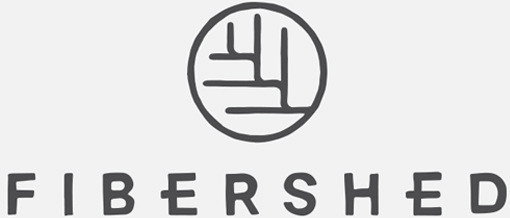Written by Lexi Fujii, Affiliate Network Coordinator. Photographed by Paige Green.
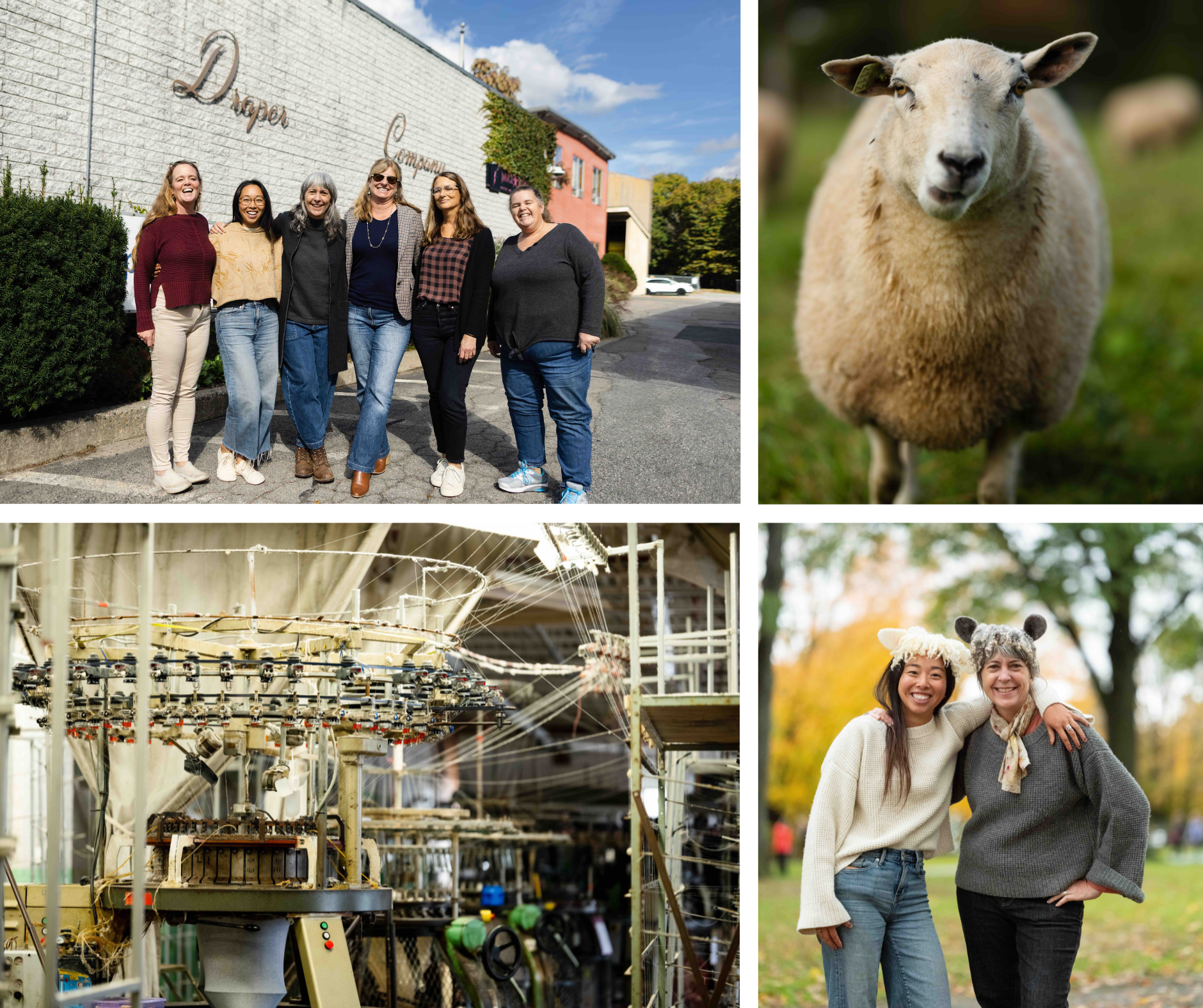
This past fall, I had the opportunity to visit Fibersheds in the Northeastern region of the United States. From touring knitting and wool mills, to visiting pastoral landscapes and wool washing facilities, I road tripped from Cape Cod, Massachusetts to Rhinebeck, New York, where I met up with ten fibersheds from our Affiliate Network at the New York Sheep & Wool Festival. Below is the story of this trip and the story of fibersheds; of the people working within their community rebuilding soil-to-soil textile systems and why that matters.
Southeastern New England Fibershed
I wake up to a light, drizzling morning in Cape Cod, Massachusetts, surrounded by deciduous and evergreen trees and what is known here as “pond culture.” Everywhere you look, there are tended gardens, ponds the size of lakes, and trees contending with the changing seasons. I am traveling with Amy DuFault, the organizer for the Southeastern New England Fibershed, and Paige Green, a California-based photographer who has been documenting Fibershed since before it was a non-profit organization over 12 years ago.
There are few opportunities for the average person to tour a mill. And to be honest, prior to working at Fibershed, I had no idea textile mills really existed in the United States (since I knew so much of American clothing is made abroad). Today we’re visiting Draper Knitting Mill in Canton, Massachusetts — which has been open since the 1850s, and is still run by the Draper family. On our drive from Cape Cod, we pass the abundance of ever-changing leaves, with the most brilliant yellows to reds; Fall is palpable here.
As we pull up to Draper Knitting Mill, I can see the evolution of time from its opening almost two centuries ago, to now, where the mill shares a front door with a Dance Studio. We meet Kristen Draper and her team upstairs in an open room, one wall lined with a family tree stretching the width of the building and featuring over 350 known family members.
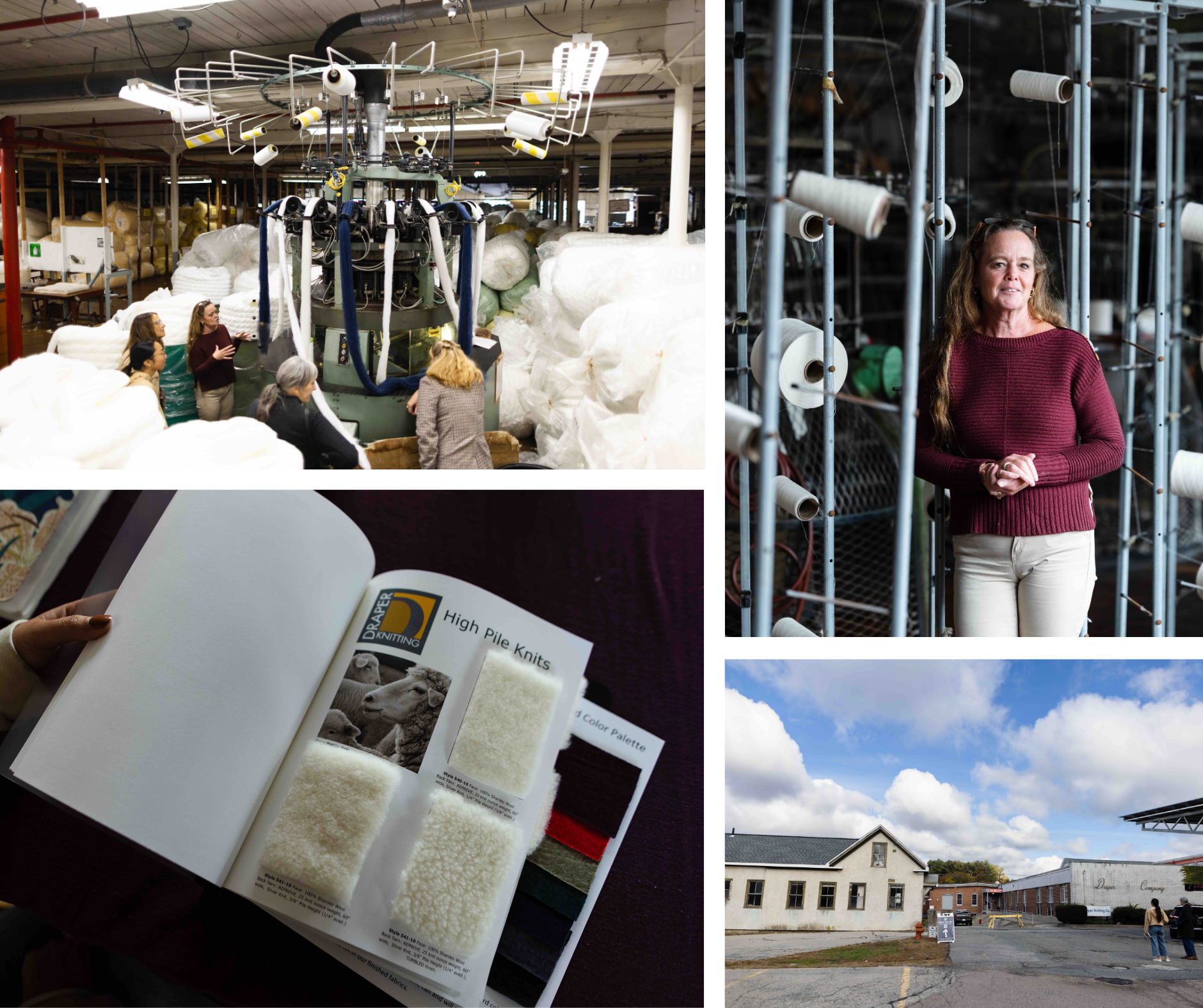
Draper Knitting Mill, which used to include Draper Felt Co., was started by two brothers knitting wool lace and military fabrics in the 1850s. In the 1980s, the family sold Draper Felt Co. and focused solely on knitting, which continues today. For a while the mill focused on footwear production, until much of it went overseas in the 1980/90s. Now, a women-owned and operated business, Draper Knitting Mill employs 30 people and produces anything from sliver knitting for pile fabrics, stitch-bonded non-wovens, blended fibers, and circular knitting. They also produce paint rollers, safety and military uniforms, and most recently launched their Wool Bar in early 2019 — a series of 100% wool fabrics, produced and milled in the United States, a rare find in this day and age where material production is opaque and has largely moved overseas.
You walk into the mill and simultaneously feel like you’ve journeyed back in time while seeing the future of American textile production. It is emblematic of the time we’re in. Fibershed Affiliate regions, both around the country and world, struggle to transform their raw plant and animal-based materials into yarns and other textile products due to the loss of small and midscale manufacturing. And yet, we see a resurgence of interest — out of necessity and out of curiosity — in localizing the means of production, supporting more transparent and direct supply chains, and working with materials coming from the land. The biggest gap to connect local supply chains, is fiber processing. We need companies like Draper Knitting Mill to stay in business.
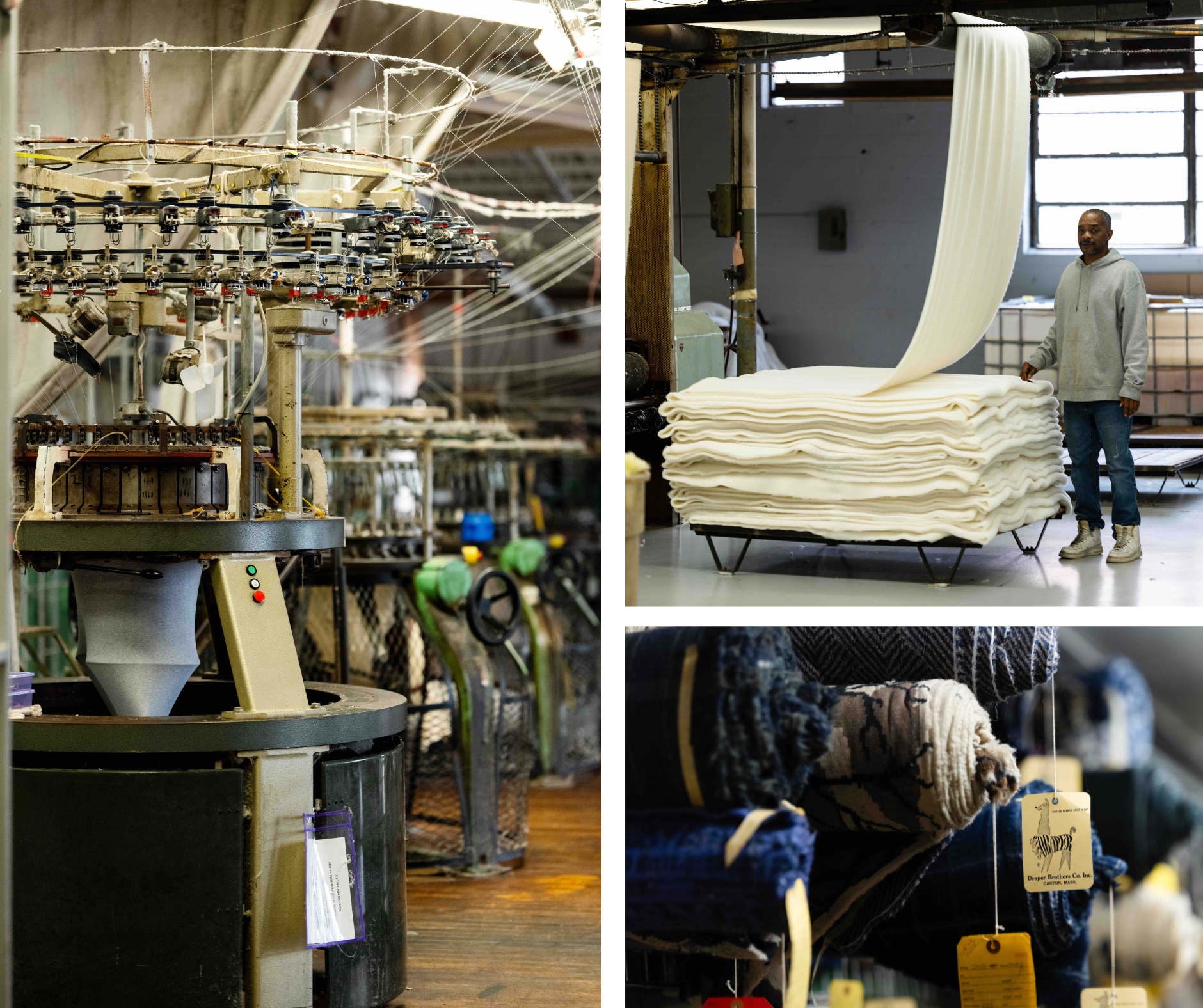
There’s a trend right now with companies wanting to connect further back into the supply chain, wanting to work more directly with the producers and manufacturers themselves. Unlike the perspective of most brands and designers, Draper Knitting Mill looks at the raw material itself — wool — and asks: “What does the fiber want to be? What can the machine make?” And then they go from there. As mentioned, they’ve recently created a series of domestically-grown and produced wool fabrics, available to designers at any scale and utilizing one yarn type in order to help with manufacturing efficiencies and material accessibility.
Amy Dufault is a woman who sees endless possibilities and is an incredible connector — a wonderful recipe for a fibershed organizer. She recently started working with Draper Knitting Mill, connecting them with local designers and looking at all the possibilities to expand in ways that can support the Southeastern New England Fibershed’s challenges with waste wool, fiber processing, and natural dye production. It’s impossible not to see all of the potential amongst me as we walk through the historic mill.
Our next stop is unconventional and unexpected: The Massachusetts Alternative Septic System Test Center (MASSTC), where researchers are challenging the concept of “waste.” In my mind, waste refers to a byproduct in a linear system. In many American communities, our human-produced waste is picked up or diverted away from our eyes, and processed offsite. In a circular system, there is no waste because the byproduct of one part of the system, is the input for the next part of the system.
As we walk around MASSTC, all around us there are roughly two dozen sheds, each holding 1-5 septic research projects. MASSTC manages private and grant-funded projects in tandem with their research partners. One such project example includes looking at how soil and various plants can “treat” wastewater and, after it is treated, understanding what the water is safe for. I look out onto small plots of land on the property — some wild-looking, others cultivated with pipelines running through. You might be wondering: what is Fibershed doing at a septic waste water treatment center?

Two years ago, Amy and I started the Fibershed Waste Wool Working Group to examine why so much wool was going to waste and what could be done about it. This began Amy’s journey of looking at all so-called “waste,” which landed her at MASSTC, researching how natural dye plants can be grown with different waste effluents while also incorporating waste wool mulch. You can learn more about this project on the Southeastern New England Fibershed’s blog. Although Amy and the MASSTC team are still analyzing the results from their urine fertilizing research, this experience opens up the door to really interesting discussions around agricultural and material systems and their “waste streams.”
We make our last stop in the Southeastern New England Fibershed the following morning, heading straight to Peterson Farm & Shepherds — one of the oldest farms on Cape Cod. If Draper Knitting Mill is the story of revitalizing American Manufacturing, and MASSTC is the story of innovating waste streams, then Peterson Farm & Shepherds is the story of the next-generation farmer.
As we pull up on a short country road, I feel like I’ve stepped into a beautiful pastoral painting — sleeping sheep surrounded by a vibrant and verdant environment, both sheep and land clearly well taken care of by their stewards. Although the shepherds are not present, with permission, we step over the electric fence and slowly greet the sheep, who wearily and lazily look over us.
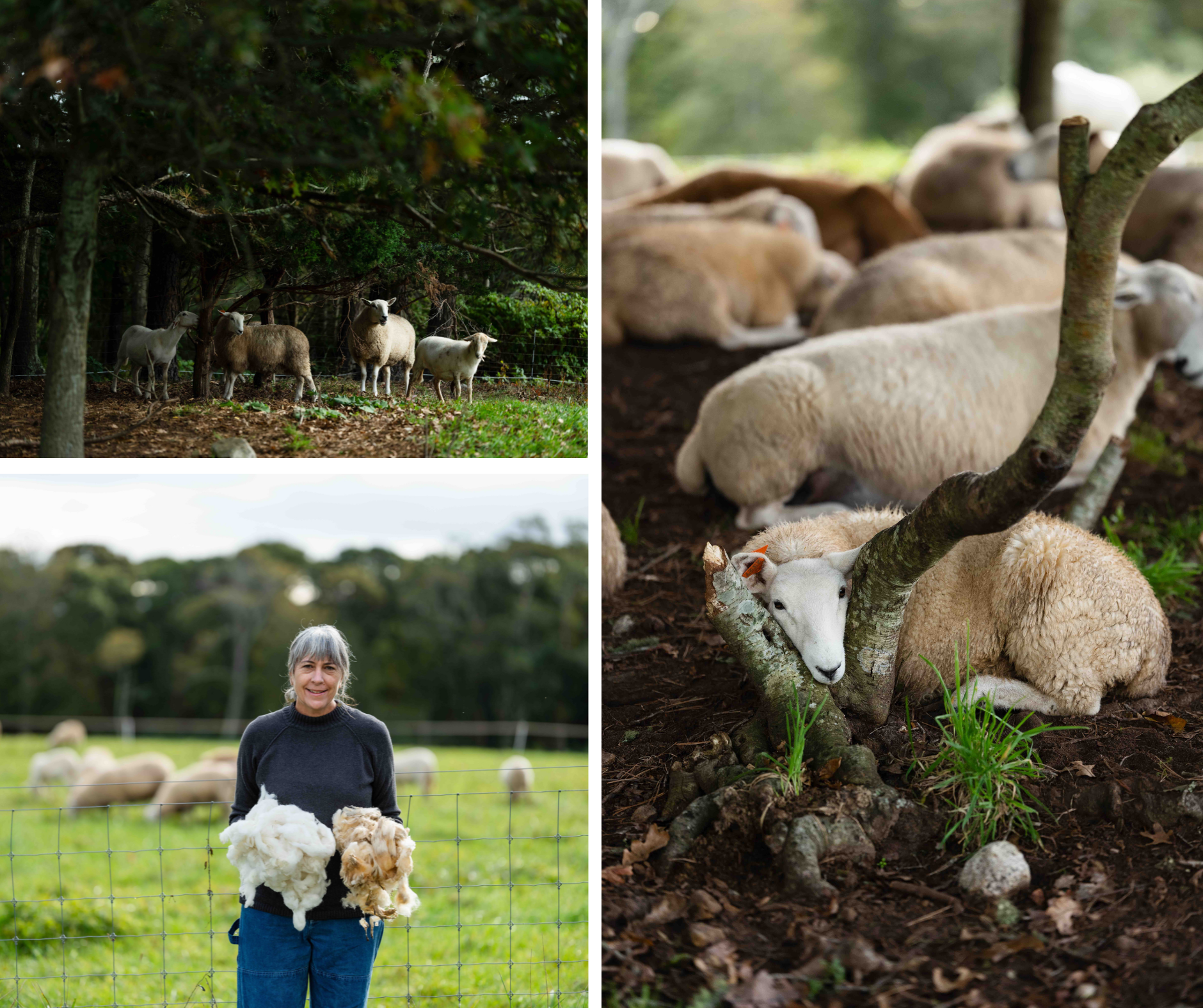
Peterson Farm & Shepherds is currently being stewarded by Diana Wickman and Simon Thorrold, who strategically use rotational grazing with their herd of North Country Cheviot and Katahdin sheep to build the health of their soil and pasture while sequestering carbon. The farm produces pasture-raised meat, pelts, dryer balls, and most recently, a wool-stuffed duvet/ comforter. They are actively looking to partner with other designers and makers to turn their beautiful wool into usable, sustainable products for their community and ensure their wool does not go to waste.
I appreciate Diana’s sentiment found on their website: “I am especially passionate about educating and encouraging future potential farmers, especially young women. I want girls to know that working with power tools and driving tractors is something they can do, too!”
Northern New England Fibershed
This whole trip, I feel like I’m in a Northeastern dream… And that dream continues as we say goodbye to the sheep. and begin to head north, into the Northern New England (NNE) Fibershed, where we plan to meet some of the NNE Fibershed organizers in New Hampshire at Sanborn Mills — a 400-acre educational farm and craft center.
The Northern New England Fibershed is cultivating regional natural fiber systems in Vermont, New Hampshire, and Maine that nourish soil, protect land, and support community. Sanborn Mills is both the fiscal sponsor and physical education center for the NNE Fibershed. We meet up with Lea Rossignol — co-organizer of the NNE Fibershed, and Sara Goodman — a talented natural dye artist and teacher. They tour us around the old grist and saw mill used for community demonstrations and the newly renovated woodworking, blacksmith, and natural dye studios. I’m in awe at how craft is bridging food, fiber, and other material systems in one place. There are oxen and draft horses to cultivate the fields and to replace diesel tractor needs, a natural dye demonstration garden, and over two dozen sheep grazing in the far fields of the farm. At Sanborn Mills, community members can re-skill themselves in many art forms while connecting back to the land, animals, and humans that tend to the landscapes.
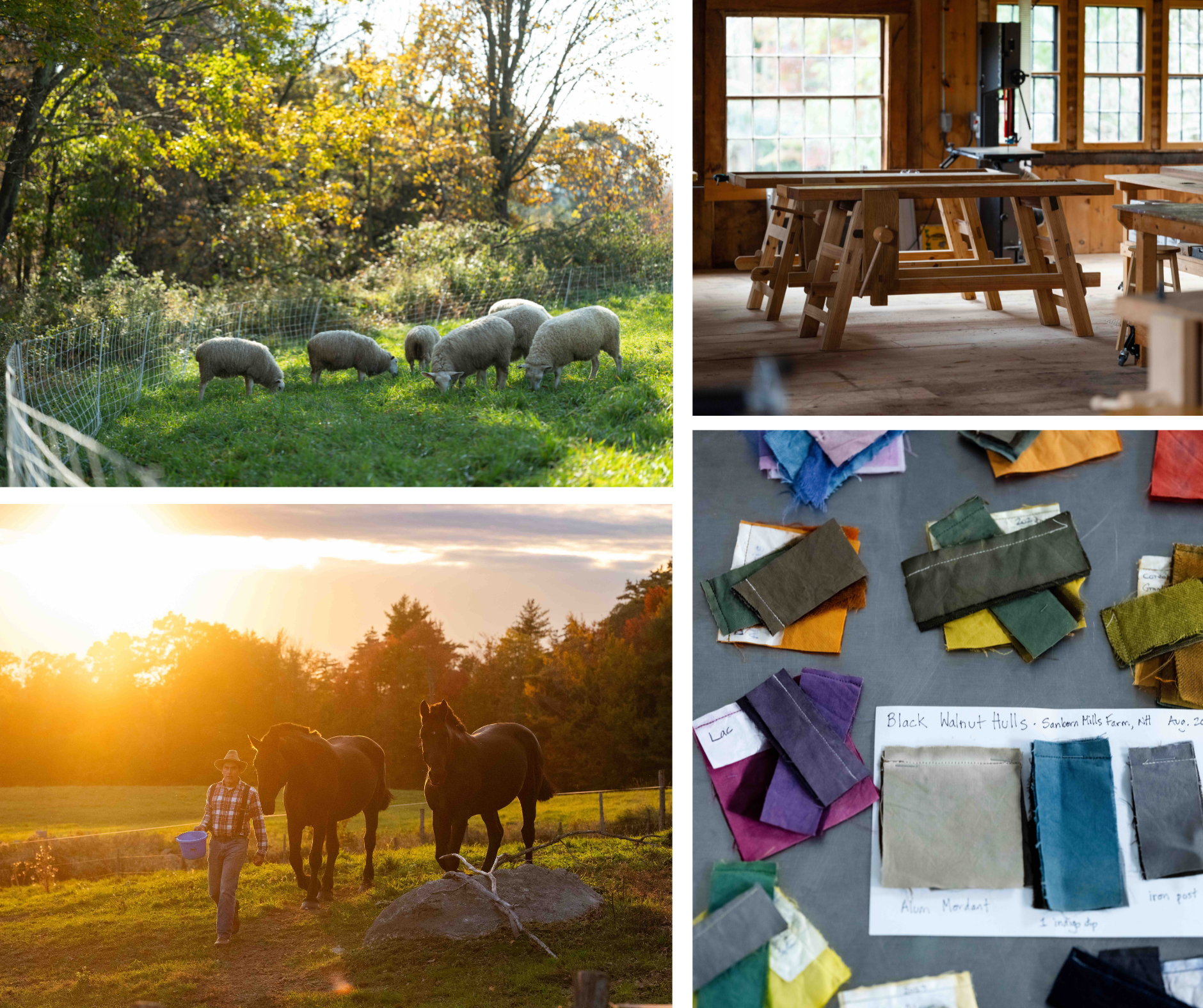
Beyond the educational opportunities at Sanborn Mills, the NNE Fibershed is working to map and connect their natural fiber and dye producer community, running a Bast Fiber working group to research the feasibility of creating a bast fiber processing facility in their region, and hosting Design Challenges to connect makers with the regional landscape and natural materials. The work from their 2023 Design Challenge will be a part of a traveling exhibition in the fall and winter of 2024 and the spring and summer of 2025.
Amy, Paige, Lea, Sara, and I spend the rest of the evening dyeing with indigo, basking in the setting sun as sheep enter the barn for the evening and the draft horses munch on their hay, and enjoying a warm bowl of chili together. We discuss the beauty of the systems we are working to create; and the gnawing challenges of creating these systems, while feeling connected by our collective purpose and vision in our different regions. In any movement-building effort, especially one with an international network, I am repeatedly reminded of the importance of community and shared experience. No change happens in isolation. Whether we like it or not, our human experience is interconnected with all of the living and non-living systems on this planet, and we must respect and be mindful of how our actions will always have a reverberating impact on everything else. I go to sleep with the fresh fall air on my face, a belly full of homemade chili and bread, and continue into my Northeastern dream.
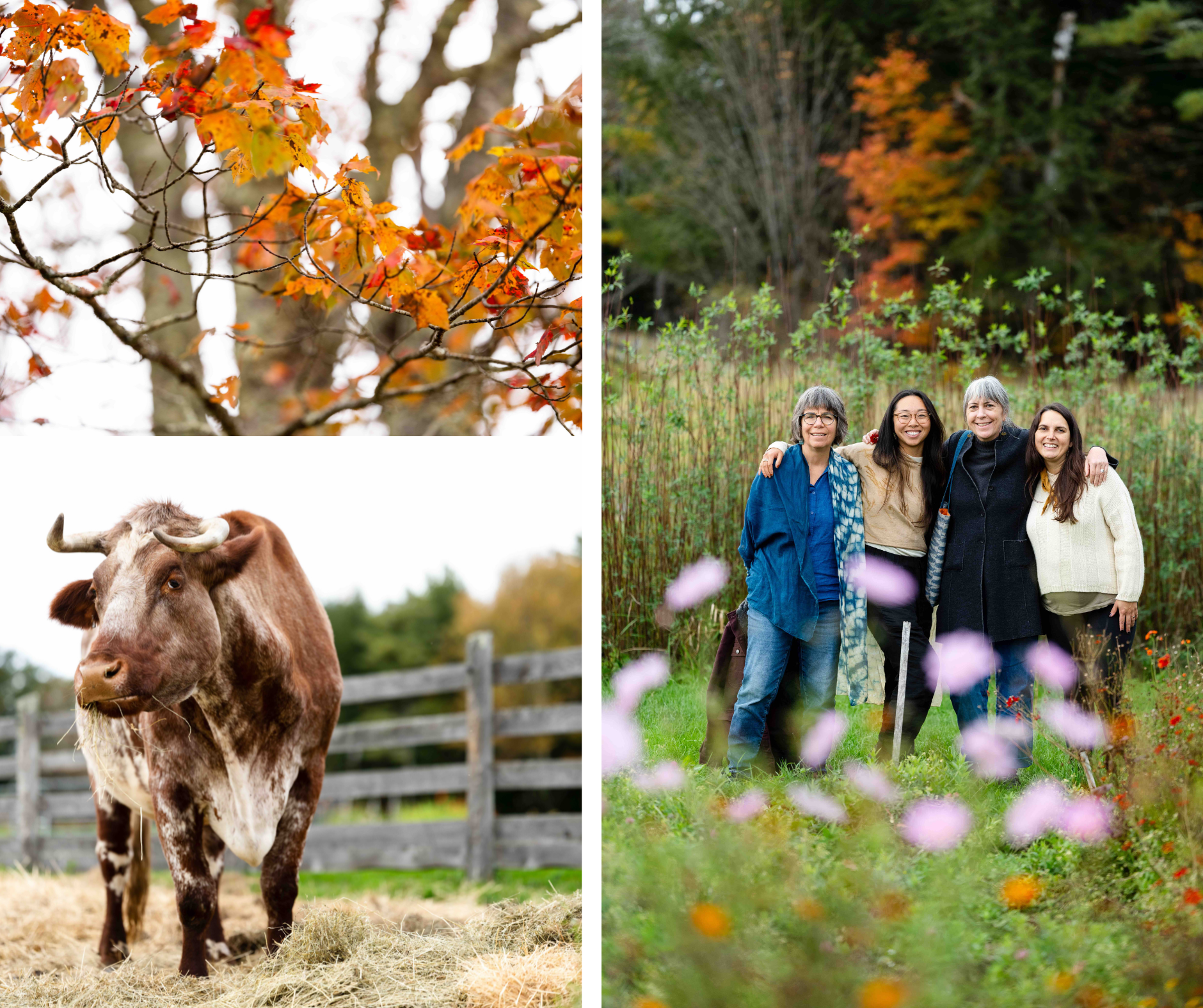
New York Fibershed
Since we started our trip, Paige, Amy, and I have already driven through three states, and on day three, we will add two more to the list as we make our way to upstate New York. We’ve planned to visit Battenkill Fiber Mill and Clean Fleece New York — both businesses Amy and I connected with through our Waste Wool Working Group.
For 1.5 years, Amy and I invited researchers, farmers, business owners, and entrepreneurs onto our monthly group calls to understand the infrastructure gaps in wool processing, and to explore all of the ways wool can be utilized. At the beginning of this working group, we explored wool product ideas and research, but the conversation always went back to one thing: wool processing, and more specifically, wool scouring (aka washing). It was already known to Amy and me that one of the biggest challenges throughout Fibershed regions was the manufacturing gaps (see research and maps Fibershed did for the Western US back in 2017). However, hearing the repetitive stories in this group underscored this challenge.
We began inviting professionals who focused on fiber manufacturing. One of those presenters was Mary Jeanne (MJ) Packer — one of the owners of Battenkill Fibers, a carding and spinning mill in upstate New York. MJ is also a co-founder of the Hudson Valley Textile Project (HVTP), a community of farmers, dyers, millers, designers, makers, distributors, and retailers who have come together to share their knowledge and resources. One of the latest projects of the Hudson Valley Textile Project is Clean Fleece New York (NY) — a new regional scouring facility. As Amy and I planned our Northeastern trip, we knew we had to visit Battenkill Fibers and Clean Fleece NY, before heading to Rhinebeck.
Battenkill Fibers is located in Greenwich, NY, and situated in two large warehouses where natural fibers — primarily wool — can be processed from its raw state all of the way to a spun yarn, including small batch dyeing. We walked through the mill, meandering through large machinery working to turn raw material into beautiful and functional goods. Not many people in the United States can say they’ve been in a fiber mill, and this is the second one I’ve been to this week. As we see more and more mills at all scales go out of business due to financial strains, retirement, or global competition, I am reminded that this is the opposite direction we need to go if we are to rebuild regional natural textile systems.

It is a relief (and uncommon sight) to see the young woman known as “T,” running one of the two spinning frames at Battenkill Fibers. Labor is difficult to find for many mills, as young individuals do not want to or do not have the skills to work in manufacturing, especially with only one mill trade school left in the United States. This is a dying industry, but also one we desperately need. As mentioned before, mills like Battenkill Fibers and Draper Knitting Mill are pinnacle points in the natural fiber supply chain. If we want to create systems of making that begin at the soil, we need to uplift everyone at every point of the process.
After touring the wool mill with MJ, we make our way 16 miles to Mechanicville, NY, where the newly established Clean Fleece NY is located. Currently focused on wool washing, Clean Fleece NY has been testing their new Kiwi Scour machinery with HVTP members, but recently, they have begun opening their doors to all customers interested in scouring their wool.
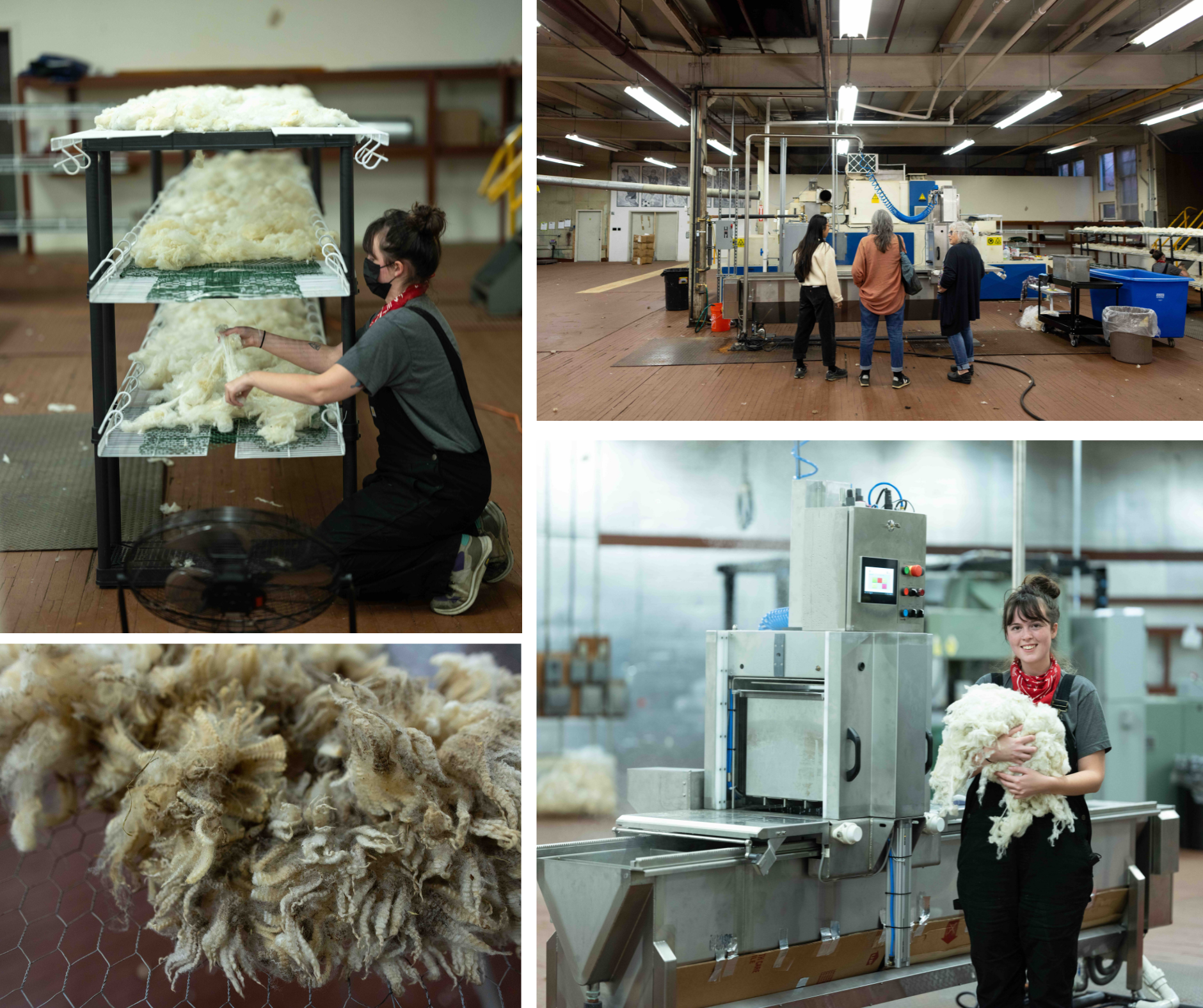
HVTP also recently received a $1.7 million grant, as part of a consortium that was awarded a total of $9 million from Empire State Development to create a NY Fashion Innovation Center. With this new funding, HVTP plans, among other things, to extend its operations to establish a wool warehouse that will provide wool classing, grading, and inventorying — other crucial steps in the process of attracting large commercial buyers for New York wool. HVTP seeks to have their Clean Fleece NY become a “one stop shop” for local natural textiles that can begin with them and move on to Battenkill Fibers or other mills to get spun.
Not only is Clean Fleece NY helping solve the scouring problem in their region, but they also want to help other groups set up successful scouring line operations in their regions. A “regular” person wouldn’t think washing wool is exciting, but as people who have followed Clean Fleece NY’s journey for over a year and understand the challenges of waste wool, Amy and I are ecstatic as we watch the Kiwi Scour get turned on and dunk dirty wool into compartments of hot water. Our trip has been made!
We sadly did not have time to tour the New York Fibershed’s Carbon Farm Network of farms and designers, organized by Laura Sansone of the NY Textile Lab, but it feels important to mention the incredible work that is happening through this project. The New York Carbon Farm Network is a purchasing cooperative made of small brands, independent designers, and Climate Beneficial™ fiber farms implementing carbon farm practices on their lands. They are also a key partner in the Climate Beneficial Fiber Partnership, along with Fibershed and four other organizations, as we work to make landscape-level change throughout the country.
New York Sheep & Wool Festival, Rhinebeck, NY
We have reached our final destination. The next three days are a fiber frenzy; from set up to close down, it is nonstop. I am here with ten other Fibersheds, mainly from the Northeastern US: Northern New England Fibershed, Southeastern New England Fibershed, Western Massachusetts Fibershed, Connecticut Fibershed, New York Fibershed, New Jersey Fibershed, Rust Belt Fibershed, Central Appalachia Fibershed, Chesapeake Fibershed, and Southern California Fibershed. It’s an incredible feat to gather this many Fibersheds in one area — to truly show the importance and vision for local fiber and dye systems and the movement we’re a part of. Because despite this being a sheep & wool festival, I was astonished by how many fibers and yarns came from other countries on the other side of the globe and how much synthetic dyes and even yarns I saw being sold.
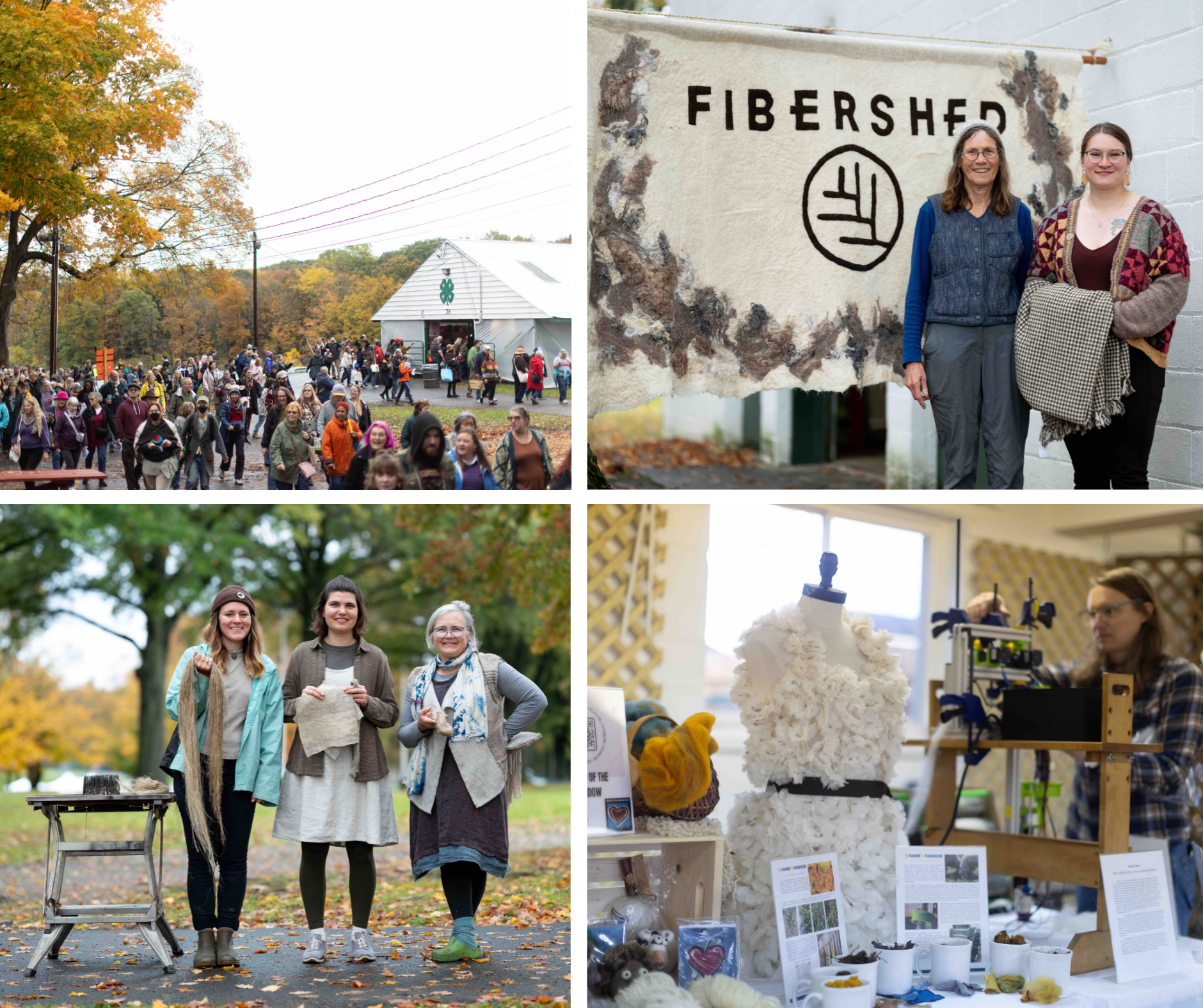
There is a beautiful array of vendors and attendees invested in the handcraft community. Still, there were more people than I could count who were not thinking about regionality, the impact of materials on the environment, and the network of farmers that do exist in the northeast and domestically in the United States. On paper, you would assume us Fibersheds would be speaking to the choir at the festival, yet instead, we were a voice not many were hearing. We were a call to action to connect with and understand the local Climate Beneficial fiber farmers, processors, makers, and brands, creating a textile and fiber system right here. We collectively spoke to hundreds of artisans, students, families, teachers, and curious citizens who got to pound color out of flowers, process hemp fiber, learn about natural dyeing and waste systems, demo mending and the art of repair, and see the abundant manifestations that fibersheds can be.
Returning Home
It is incredible to me that in seven days, I was able to experience the Northeastern Fibershed region all the way from soil-to-soil: Sheep grazing on healthy pasture and young carbon farmers advocating for climate beneficial agriculture practices; regionally-scaled natural fiber mills turning raw material into clean fiber, yarns, and fabrics; meeting designers, makers, educators, conscious consumers alike wanting to create or invest in local, sustainable goods. As I make my way back to California, I feel exhausted yet so full — full of life, beauty, and awe at everyone working together to shift the culture of making/consuming into one that embodies collaboration, respect, and ecological balance. And I hope that the future continues to look like my Northeastern dream.
—
